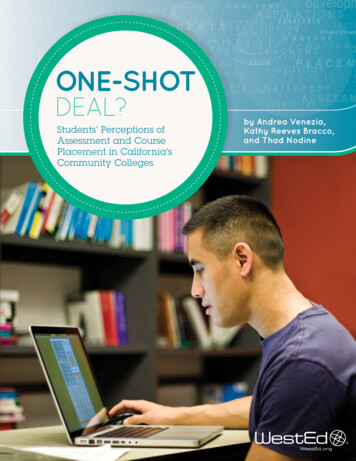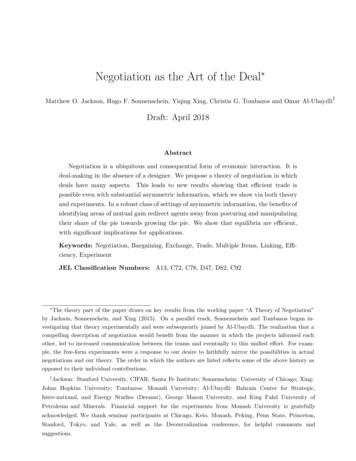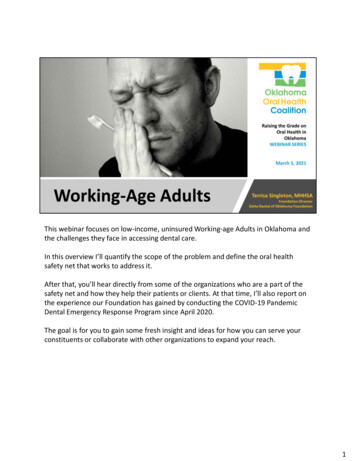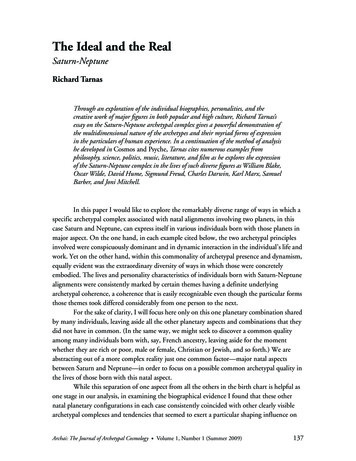
Transcription
ONE-SHOTDEAL?Students’ Perceptions ofAssessment and CoursePlacement in California’sCommunity Collegesby Andrea Venezia,Kathy Reeves Bracco,and Thad Nodine
WestEd — a national nonpartisan, nonprofit research, development, and service agency — works witheducation and other communities to promote excellence, achieve equity, and improve learning for children, youth, and adults. WestEd has 17 offices nationwide, from Washington and Boston to Arizona andCalifornia, with its headquarters in San Francisco.For more information about WestEd, visit WestEd.org; call 415.565.3000 or, toll-free, (877) 4-WestEd; orwrite: WestEd / 730 Harrison Street / San Francisco, CA 94107-1242.Copyright 2010 WestEd. All rights reserved. No part of this publication may be reproduced or distributed in any form or byany means, or stored in a database or retrieval system, without the prior written permission from WestEd. A full-text PDF of thisdocument is available as a free download from www.WestEd.org. To request permission to reproduce excerpts from this report,contact the WestEd Publications Center, 730 Harrison Street, San Francisco, CA 94107-1242, or permissions@WestEd.org.Suggested Citation: Venezia, A., Bracco, K. R., & Nodine, T. (2010). One-shot deal? Students’ perceptions of assessment andcourse placement in California’s community colleges. San Francisco: WestEd.
AcknowledgmentsThis study analyzes a system that has undergone much public scrutiny in recentyears and that is currently facing substantial fiscal challenges. Aware that peoplewithin the community colleges are working extremely hard with diminishingresources to provide student services, we were careful to include their insider perspectives as well as those of people outside the system. Similarly, we strove to frame ourfindings and recommendations in an appropriate and balanced way.We owe a debt of gratitude to Michael Kirst for being involved in this project every step of the way, notably providing his wise perspective on the context of California education within which the community college issues playout. We are also grateful for the experience and expertise of each of the project’s advisory board members (seebox). In addition, our report reviewers—Jan Connal,Tracy Huebner, Kathy Hughes, Jorge Ruiz de Velasco,Advisory Board Membersand Paul Steenhausen—gave generously of theirtime and provided us with thorough and thoughtfulcomments.Mark Wade Lieu, OhloneTom Bailey, Teachers College,CollegeColumbia UniversityWe also thank the William and Flora Hewlett FoundaMorgan Lynn, CaliforniaBob Barr, Foothill De Anzation for its generous support, and we are grateful to itsCommunity CollegesCommunity College Districtprogram officers, Pamela Burdman and Denis Udall, for theirChancellor’s Officeconsistent engagement in this work. And we thank the WalterSteve Bruckman, CaliforniaLinda Murray, EducationCommunity CollegesS. Johnson Foundation for a generous infusion of funds forTrust–WestChancellor’s Officedissemination activities.Jorge Ruiz de Velasco, EarlGeorge Bunch, UC Santa CruzWe wish to thank our colleagues, Michael Kirst, Su JinWarren Center, UC BerkeleyJez, Seewan Eng, Sarah Feldman, Miriam Maya, andKate Clark, Irvine ValleyBarry Russell, CaliforniaCollegeSoung Bae, for conducting field research. Su Jin JezCommunity Collegesoversaw the quantitative analyses and Seewan Eng orgaJan Connal, Cerritos CollegeChancellor’s Officenized the qualitative analyses. Sitome Mebrahtu, KatieBob Gabriner, San FranciscoJessie Ryan, Campaign forRanftle, and Melissa Josue provided invaluable logisticalState UniversityCollege Opportunitysupport. WestEd’s Health and Human DevelopmentKathy Hughes, TeachersMichele Siqueiros, Campaignteam lent their expertise in conducting the telephoneCollege, Columbia Universityfor College Opportunitysurveys with matriculation officers. Sara Miller led thisteam of researchers and provided overall leadership onEsther Hugo, Santa MonicaPaul Steenhausen, LegislativeAnalyst’s OfficeCollegethis aspect of the project. Sara was assisted by CissyLam, Sara Hahn, Gregory Loar, LeAnn Adam, andAcknowledgments
Yanessa Bowser. Greg Austin and Barbara Dietsch were very helpful in the development of the survey instrument.Thank you, too, to our talented editor, Joan McRobbie; to Rosemary De La Torre for her eagle-eyed line editing andproofing; and to Michael Medina for his creative layout and design work.Perhaps most importantly, however, we thank the college students and counselors who participated in interviewsand focus groups. Community college students have little free time, but they actively engaged in talking about howcampus policies and practices affect their lives. Throughout this report, we discuss how busy counselors are, yetat all five campuses, counselors were eager to discuss ways to improve student learning and academic success.We also thank the matriculation officers who responded to our phone survey and those who helped us gainaccess to students and counselors at their colleges. Although we cannot name you because we promised youanonymity, you know who you are, and we could not have done this study without your trust and heavy lifting.Acknowledgments
onclusion24Appendix: Methodology25Reference List27
IntroductionThe California Community Colleges system, with an enrollment of about 2.9 millionstudents annually at 112 colleges, is the largest system of postsecondary educationin the world. Open enrollment policies at the colleges ensure that anyone age 18 orolder can attend, and younger students can take courses as well. By providing thisopportunity, California has, year after year, opened the doors of higher educationto a substantial portion of its young population. The state has been less successful,however, in preparing high school students to succeed in college-level courses andensuring that those in college complete their postsecondary educational programs.1Several studies, including our own previous research,have examined student perceptions of the transitionsand barriers between K–12 and postsecondary education systems. These studies have recommended betteralignment of coursework and assessments between thetwo systems to ensure that high school students arebetter informed about and prepared for college-levelacademic work.2 There is substantial work being done—in California and nationwide—to develop college readiness standards; expand concurrent enrollment programs;communicate clearly about the key cognitive strategiesnecessary for postsecondary success (e.g., analyticalthinking); improve student supports; and implementother approaches to improve students’ postsecondaryreadiness and success.This report focuses on assessment and placementprocesses, pivotal pieces of this picture because theydetermine which level of courses students will be placedin when they begin community college.This study had two main purposes. One was to examineand describe the set of policies and practices that shapeassessment and placement in California’s communitycolleges. The other was to hear directly from students—whose voices are crucial yet generally missing in the policyprocess—about their assessment and placement experiences. We then compared the policies’ supportive intentwith the reality of the students’ experiences—as well aswith observations from counselors and matriculationofficers—to draw conclusions about how the policies andpractices may need to be adjusted.Unquestionably, the assessment and placement processinvolves very high stakes for students. Whether studentsare placed immediately in college-credit or transfer-levelcourses in English and mathematics3 or are insteadrequired to start with basic skills courses has a majorimpact on students’ trajectories. Course placement1A survey of assessment results in California’s Community Colleges found that 83 percent of community college students placed in remediallevel mathematics, and 72 percent placed in remedial-level English. See California Community Colleges Chancellor’s Office (2009).2See, for example, Venezia, Kirst, and Antonio (2003).3Not all courses require prerequisites or placement testing.Introductionpage 1
affects not only how quickly they can earn a certificateor degree—a factor affecting the cost of their programof study—but also their likelihood of completing acredential at all.Studies show that fewer students who place into basicskills courses complete their intended educational pathsthan do students placed in transfer-level courses. Thosestarting with basic skills courses who do complete acertificate or degree tend to take longer than their peerswho are college ready. Notably, some studies have calledinto question whether remedial education is worthwhileat all, since even students who seem to need more basicsmay have better outcomes without remedial courses(Jenkins, 2010).With so much riding on assessment and placement, it isimportant that students know the requirements earlyin their high school years so they can master theneeded knowledge, skills, and cognitive strategies.They need ways to gauge their level of preparationand get the support they need—in high school and incollege—to succeed. But such seamless processes donot appear to be the norm. On the contrary, community college students describe assessment and placementas something they encounter for the first time uponarrival at the college. They describe an isolated eventthat happens one day with minimal to no advanceinformation. They walk into a testing center and takea test that seems disconnected to any recent academicwork they had in high school. They receive a printoutof their results and then register for courses. Manydo not meet with a counselor to discuss their testresults, and believe they are on their own to determine course-taking options. Thus, while counselorsand matriculation officers have set up a continuum ofservices, most students believe that matriculation servicesare a one-shot deal—something that happens over thecourse of one day and is never revisited.Their stories make it clear that although the assessmentand placement processes are crucial to students’ engagement, perseverance, and ultimate success, students hearlittle about them in high school. They arrive at communitycollege knowing next to nothing about what to expect,and, thus, are unprepared to affect their own outcomes.We have directed our recommendations toward developing a more seamless, longer-lasting set of processeswherein high schools and community colleges aligntheir efforts toward informing and preparing students.In addition, during this time of scarcity, we focused onfinding and recommending better efficiencies. That isadmittedly difficult, since what students most want ismore one-on-one time with counselors, an expensiveintervention.The Study’s ApproachDespite many studies about the placement assessments,4little is known about students’ related perspectives andexperiences. Unanswered questions include:»» Do incoming students—particularly high school graduates—typically know that they will be assessed beforethey can enroll in rigorous college courses?»» Do students prepare for the assessments, and, if so, how?»» How do students describe the course placement processand its impact on their educational goals and achievement?»» What are the areas of variation and consistency—in collegepractices and in student perceptions—across the state?Addressing these questions is critical to understanding—and improving—how high school students prepare forcollege and how colleges serve underprepared students.To find answers, our research included two components.First, we conducted focus groups with students at five community colleges throughout the state, with a primary focuson students not more than two years out of high school.(See the appendix on page 25 for a full description of themethodology.) Students were asked about their experienceswith assessment and placement practices at the collegesand about their high school experiences related to collegepreparation. Secondly, we interviewed counselors at thefive colleges and also surveyed matriculation officersacross the state (total of 73 colleges), basing the questions we asked on preliminary findings from our studentinterviews. Throughout the paper we incorporatestudent quotes and identify their colleges with A, B, C,D, or E and the classes they were in for the focus groupwith designations such as “transfer,” “non-transfer/basicskills,” and “ESL.” Since we used focus groups to gather4This research did not study the effectiveness of the assessment and placement instruments. We did not address whether the assessmentinstruments or the cutoff scores used at the colleges are valid or reliable. These are important questions requiring further research, but they arenot the focus of this study.Introductionpage 2
information from students, we often cannot provideexact numbers regarding how many students experienced particular concerns or frustrations. In order for anissue to merit becoming a finding, it had to be discussedin multiple focus groups with general agreement.The California ContextCalifornia’s community colleges face the challenge ofaccurately assessing a large number of students whoenter college at a wide range of readiness levels andwith diverse academic and career interests. Underthe local, decentralized governance structure of thecommunity college system, each of the 112 collegesbears the financial and administrative responsibilitiesof assessing students in three areas: English, mathematics, and English as a Second Language (ESL).Each is responsible for selecting or developing its ownassessments and determining the “cutoff” scores thatcorrespond with various levels of course placementfor students.Given this structure, a large number of instruments isused across the system, though a small core of assessments is used most consistently statewide (Brown andNiemi, 2007).5 Some view these variations as important, given different student populations served andthe need for local autonomy. But the system’s use ofmultiple placement assessments causes problems. TheCalifornia Community Colleges Chancellor’s Office(2010) reports that the variations generate:»» a lack of uniformity, comparability, and mobility fromone community college to another;»» expenses related to the retesting of the same students who attend multiple institutions; and»» difficulty generating success algorithms across the statefor research purposes.In addition, having different assessments at its variouscampuses across the state makes it difficult for the5system to inform prospective students about commonreadiness levels needed for success in all Californiacommunity colleges.6As a step toward addressing these problems, the Chancellor’s Office is exploring the feasibility of incentivizingthe use of a small number of assessments systemwide byoffering those assessments to the colleges free of charge.In exchange, colleges would need to agree to includetheir test data in the soon-to-be-developed AssessmentWarehouse. The system hopes to achieve cost efficiencyby negotiating a price break based on testing instrumentvolume. Under this approach, colleges choosing not toparticipate could continue to offer locally selected andpurchased instruments, but they would then continue tobear their own costs (Perry, n.d.).Besides minimizing the number of different assessmentsacross the system, the Chancellor’s Office envisions thiscentralized approach as a means to:»» develop a secure, central data repository for communitycollege and K–12 test data;»» provide an assessment portal through which communitycollege counselors could access K–12 test results, transcriptdata, and college test data; and»» allow for the development of algorithms of placement success,based on test scores and the highest level of courses studentshave taken in that subject.Prior to the Assessment Warehouse, the Chancellor’sOffice launched the Basic Skills Initiative (BSI) in 2006,as part of its strategic planning process. Developed asadditional student support when the required courselevels for an associate’s degree in mathematics and Englishwere raised,7 the BSI also responded to concerns that toofew students would qualify for credit-level courses. Withan overall goal of improving student access and success, theBSI has two main activities: 1) providing supplementalfunding to every college to address basic skills needs; and2) providing training for faculty and staff in the effectiveSee also Legislative Analyst’s Office (2008) and Consultation Council Task Force on Assessment (2008).6The variations in placement assessments across the state make it difficult to develop testing instruments outside of the community collegesystem that might be relevant for placement, such as K–12 tests, the Early Assessment Program (EAP), or transcript data. See Perry, P. (n.d.).7In 2006, the Board of Governors adopted changes to Title 5 of the California Education Code that increased the minimum requirements foran associate’s degree. The new requirements, effective as of fall 2009, state that students had to successfully complete a transfer-level Englishcourse (English 1A or equivalent), whereas previously the requirement had been a course one level below transfer-level English. In mathematics,the new requirements state that students must complete intermediate algebra (which is one level below transfer-level mathematics) or anequivalent course, whereas previously students needed to complete elementary algebra.Introductionpage 3
delivery of basic skills and ESL (California Community Colleges Chancellor’s Office, 2009a).Another effort to improve college readiness and success, the California State University’s Early AssessmentProgram (EAP), is now also being adopted in theCalifornia Community Colleges system. The EAPcombines 11th-grade testing of college readinesswith 12th-grade opportunities to polish skills: newhigh school courses in English and mathematicsaligned with postsecondary (CSU and communitycollege) entry level expectations; and professionaldevelopment for high school teachers that is alignedwith postsecondary expectations.In another approach to improving student transitions,the Foundation for the California Community Colleges(FCCC) has funded the design or conversion of 23 EarlyCollege Schools in California. These schools providestructure and support for broad populations of students toenroll in college courses while they attend high schooland the opportunity to earn an associate’s degree uponhigh school graduation (Foundation for California Community Colleges, 2010).Discussions are also occurring about whether placementtest results should indicate a mandatory level of courseplacement for students. Technically, current placementresults are not binding; students can theoretically enrollin courses at the level they choose. Yet, as this studyfound, many colleges have mechanisms in place toensure that students select courses at the levels indicatedby placement test results.Challenges in a negative fiscal climate. The needfor action to improve student success in California collides with the reality that colleges are already trying toaccomplish more with fewer resources. Since this studybegan in 2008, Californians have suffered the consequences of a severe recession, including job losses, dropsin income, decreases in property values and wealth,increases in debt, and cutbacks in public services. Thestate’s key revenue sources—taxes on income, sales, andcapital gains—have fallen off, and the resulting declineshave thrown state budgets into disarray. In 2009,postsecondary education took a 2 billion hit, includingcuts of about 680 million at the community colleges, 584 million at California State University, and 813million at the University of California (Marcus, 2009,and Steinhauer, 2009).Student fees shot up, with increases of 30 percentat the community
College Mark Wade Lieu, Ohlone College Morgan Lynn, California Community Colleges Chancellor’s Office Linda Murray, Education Trust–West . Perhaps most importantly, however, we thank the college students and counselors who participated in interviews and focus groups. Community coll











